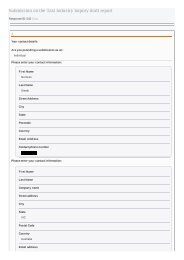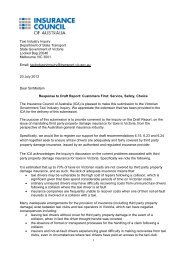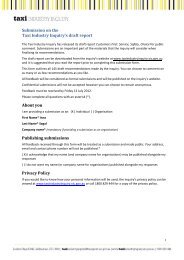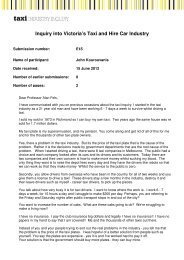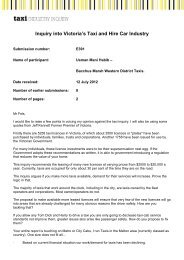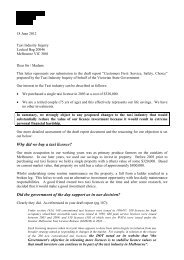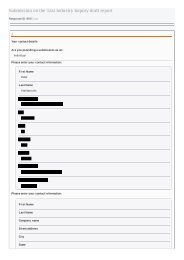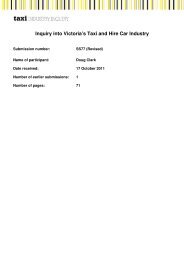Part D â Understanding and improving industry performance (PDF ...
Part D â Understanding and improving industry performance (PDF ...
Part D â Understanding and improving industry performance (PDF ...
You also want an ePaper? Increase the reach of your titles
YUMPU automatically turns print PDFs into web optimized ePapers that Google loves.
12.3.2. Dem<strong>and</strong> for electronic<br />
payment services<br />
With a surcharge that many consumers <strong>and</strong> <strong>industry</strong><br />
players consider to be excessive, it may be surprising<br />
that an estimated 40 per cent of taxi fares are paid<br />
electronically. One explanation for this can be found by<br />
examining the dem<strong>and</strong> side of the market. Consumer<br />
dem<strong>and</strong> for payment instruments <strong>and</strong> payments<br />
processing is derived from dem<strong>and</strong> for underlying taxi<br />
<strong>and</strong> hire car services. Payment systems, like taxi drivers,<br />
are inputs to the taxi service. Two factors suggest that<br />
dem<strong>and</strong> for electronic payments is likely to be inelastic –<br />
that is, not very responsive to a surcharge:<br />
• Dem<strong>and</strong> for the underlying taxi services is inelastic<br />
<strong>and</strong> therefore the dem<strong>and</strong> for payment instruments<br />
<strong>and</strong> processing is also likely to be inelastic<br />
• Service fees or surcharges remain a relatively small<br />
part of the total fare.<br />
This inelasticity is due to a lack of substitutes for both<br />
payment systems <strong>and</strong> taxis.<br />
First, there are no alternative payment methods that<br />
provide the same benefits as taxi-specific payment<br />
instruments or other electronic payment instruments,<br />
particularly for higher value fares. Carrying a large amount<br />
of cash can be insecure <strong>and</strong> inconvenient, <strong>and</strong> is not<br />
favoured by business users in particular.<br />
Secondly, the payment system is directly linked to taxi<br />
use <strong>and</strong> competition does not work effectively in these<br />
markets. Offering a lower surcharge offers minimal benefit<br />
to the operator because, in many situations, this will<br />
not lead to more business – for example, for taxis taken<br />
from a rank or hailed. Nor is there any discounting in<br />
the pre-booked market segment: it is notable that both<br />
large metropolitan networks benefit from rebates from<br />
Cabcharge derived from the 10 per cent surcharge.<br />
Limited awareness of the surcharge levied by payment<br />
system operators may also be a factor leading to<br />
inelasticity of dem<strong>and</strong>. Feedback from drivers in particular<br />
suggests that while business users are aware of the<br />
charge, other users are less aware <strong>and</strong> are likely to<br />
confront drivers if they notice it on their fare:<br />
Most business people know about the surcharge,<br />
<strong>and</strong> don’t care because the boss pays for it. The<br />
general public are the ones who do not underst<strong>and</strong>,<br />
<strong>and</strong> often they will think the taxi driver has put extra<br />
on the payment, <strong>and</strong> this can cause arguments. 8<br />
12.3.3. Network effects<br />
Payment instruments <strong>and</strong> processing systems are ‘twosided’<br />
market platforms. A two-sided platform is one where<br />
the platform acts as an intermediary between two groups<br />
of customers, creating value from transactions between<br />
the two groups. Two-sided markets have some unusual<br />
features, but perhaps the most important feature in relation<br />
to the taxi <strong>industry</strong> is the scope for network effects.<br />
In relation to payment instruments, the two ‘sides’ are<br />
account holders <strong>and</strong> taxi operators. Account holders<br />
want to hold instruments that will be accepted by taxi<br />
operators. Taxi operators want to accept instruments that<br />
will be used by account holders <strong>and</strong> taxi passengers. In<br />
a similar vein, the two ‘sides’ of the payment processing<br />
market are taxi users <strong>and</strong> taxi operators. Again, the<br />
interest is in holding <strong>and</strong> accepting cards that will be<br />
used <strong>and</strong> processed by users on the other side.<br />
These market characteristics give rise to so-called<br />
‘network effects’. Users require different functionality<br />
from the payment system, but each obtains value from<br />
interacting with users of the opposite group – in fact,<br />
the value of the payment service is dependent upon<br />
the number of other users using it. This kind of market<br />
characteristic will tend to favour concentrated markets,<br />
unless the costs to consumers or to operators of holding<br />
multiple cards or multiple payments processing units are<br />
not too high.<br />
The inquiry underst<strong>and</strong>s that many taxis in<br />
Victoria have more than one processing unit in the<br />
vehicle, which suggests a processing monopoly<br />
is not a foregone conclusion. In addition, many<br />
consumers will hold more than one type of card<br />
or payment instrument, which will allow for some<br />
competition to develop between processors.<br />
In relation to payment instruments, if the market is defined<br />
for taxi-specific payment instruments, then Cabcharge<br />
has a very strong position in this market. It appears to<br />
have largely captured the network effects <strong>and</strong> has reenforced<br />
this by integrating into payments processing<br />
<strong>and</strong> network services. In this instance, an account holder<br />
will be unwilling to choose another taxi-specific payment<br />
instrument because there is a real prospect that this<br />
instrument will not be accepted in all taxis – in particular,<br />
those with a Cabcharge processing unit.<br />
8 Christine Coombes, Comment on Taxi Industry Inquiry Facebook<br />
page, 2 April 2012<br />
254




